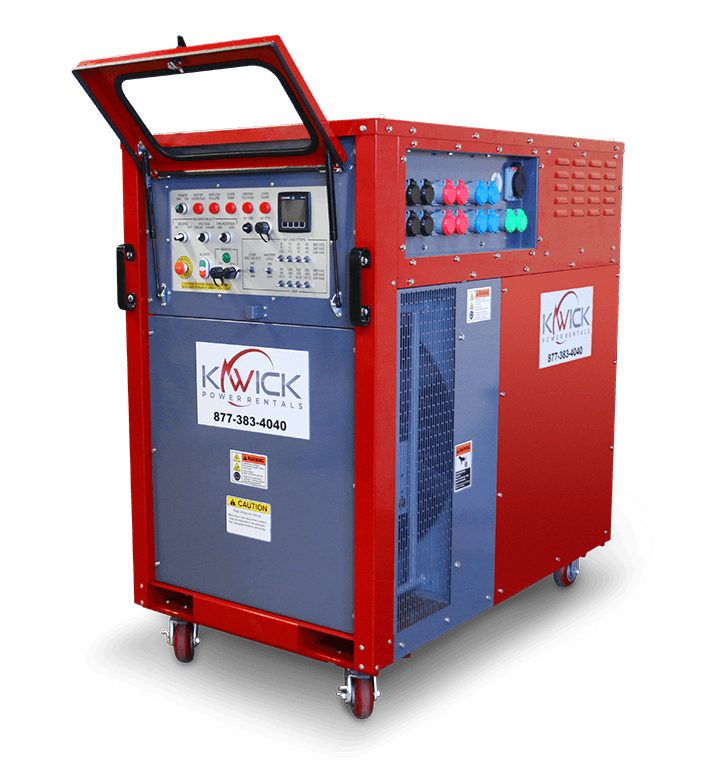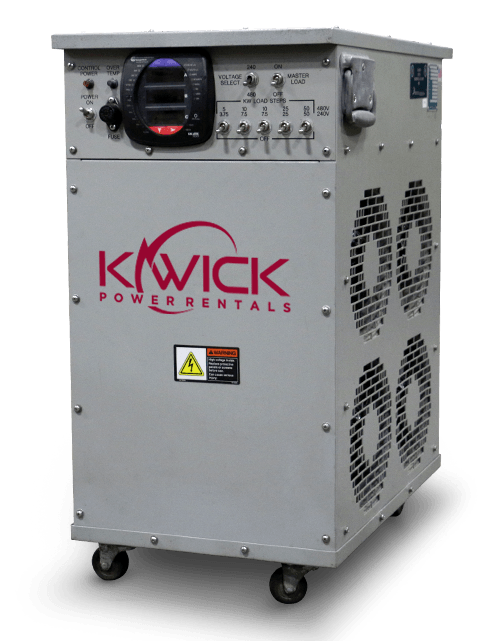Load Banks

What is a Load Bank?
A load bank can be defined as a device that produces a controllable electrical load on the circuit that it is fed from. That still might not tell you much if you have never seen or used one before. So in general, the most common type of load bank (a portable air-cooled AC resistive load bank) is like an industrial sized hair dryer. It has resistive heating elements in it with a fan or blower to cool them as well as switches for incrementally controlling the amount of load to be applied. Load banks come in different shapes in sizes, but these AC resistive load banks are typically rated in terms of their maximum capacity in Kilowatts (kW).
As stated above, "portable air-cooled AC resistive load bank" is a mouthful of a specification. It seems like there could be a lot going on there, right? Well, I will break this down in simple terms and from there you will know just about everything that you will ever need to know about these essential yet not well known pieces of equipment.
Portable or Permanent?
Load banks can permanently installed or portable. Permanent load banks can be standalone fixtures that can be used to load test a myriad of different systems within a facility. They can also be mounted to the radiator of a diesel generator, where it will typically be used for the testing or exercising of that generator. Load banks can also be portable, but portable is a term that is used pretty liberally in our industry. They can be as small as a unit that comes in a suitcase, complete with telescoping handle, or as big as a multi-megawatt load bank that is mounted on a 48 foot trailer. Huge, but someone gave it wheels, so hey, now it's "portable".
Air-Cooled or Liquid-Cooled?
99.999% (that's a rough estimate) of all load bank tests in the United States are performed with air-cooled load banks. A big part of this is due to simplicity of set up. All that you need is a cool and well ventilated space (preferably outdoors) and you are good to go. On the other hand, there are load banks out there that are liquid cooled. These can be used for doing mechanical system commissioning where the load bank is used not so much for the electrical load, but for the heat that it generates, and that load is put directly into a building's cooling medium whether it be chilled water or glycol. That involves a lot of hoses and quite of bit of engineering. It's easy to see why you would want to stick something that is air cooled instead!
Resistive or Reactive?
The last part of our original specification called for a resistive load bank. Resistive load banks are used most of the time. But what are the alternatives? You can have reactive load banks that, when used along with a resistive load bank, produce a load with a power factor other that 1.0 (either lagging or leading).
Of this subset, over almost all of these tests will be with an inductive load, causing a lagging power factor. This is common when doing in-factory testing on motor generators and uninterruptible power supplies, or field testing of these after a major repair. Engineers also like to use inductive load when paralleling switchgear is involved so they can make adjustments to how this part of the total load is shared between paralleled generators.
AC or DC?
As you may know, there are two types of electricity: Alternating Current (AC) and Direct Current (DC). When thinking about DC, batteries should come to mind. When thinking about AC, it is nearly everything else. You will need to have either a load bank rated for AC voltages or for DC voltages depending on your scenario. It matters that you have the right one because of the internal components of the load bank (one won't work for the other).
Conclusion
So there you have the most compact article of the absolute basics of load banks and load testing. While most of what people use are portable or permanent AC resistive load banks, there is much more to it than that! Have a test coming up? Please reach out to us and let us help.

Questions?
Ask Us!